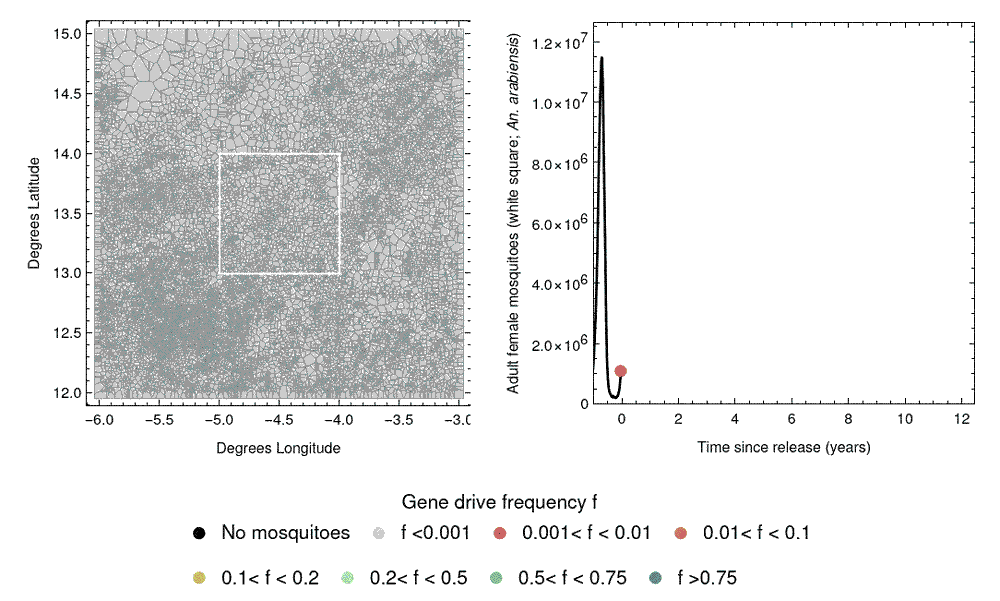Press Release
Download PDFNew mathematical modelling study demonstrates gene drives could boost malaria control when added to intervention packages including new bed nets and vaccines
Summary
- Researchers from Target Malaria have published a new mathematical modelling study evaluating the potential impact of gene drive technology on malaria incidence in West Africa.
- The study projects that gene drives could reduce mosquito malaria vector populations by 71% to 98%, leading to significant decreases in malaria cases. — at least 60% more clinical cases could be averted by adding gene drives to intervention packages including vaccines and improved bed nets.
- The findings also suggest that gene drives will be most effective if they target multiple mosquito species, especially the four major malaria vectors in West Africa: Anopheles gambiae, An. coluzzii, An. arabiensis, and An. funestus.
- Because it is self-sustaining and cost-effective, a single release of gene drive mosquitoes could have a strong impact on the number of averted cases, especially in rural and remote areas.
LONDON, United Kingdom, 20 November 2024 – The Target Malaria UK modelling team at Imperial College London has published their latest study in Nature Communications, titled “The potential of gene drives in malaria vector species to control malaria in African environments”. This study explores the impact that mosquitoes modified with the gene drive technology could have on malaria incidence if deployed in West Africa. To conduct the research, scientists used a mathematical model to test various hypotheses on the epidemiological efficacy of gene drives.
“We simulated gene drive releases in different West African locations to investigate how gene drive technology could reduce malaria prevalence in a wide range of environments”, says lead author Dr. Ace North, Researcher at the University of Oxford and lead modeller at Target Malaria UK.
The model incorporated data from 16 locations across 13 malaria-endemic countries—Senegal, The Gambia, Mali, Guinea-Bissau, Ghana, Nigeria, Cameroon, Sierra Leone, Liberia, Guinea, Togo, Benin, and Côte d’Ivoire—factoring in landscape features, climate, mosquito species, malaria prevalence, and interventions like insecticides, drug treatments, and vaccines.
“This novel approach to modelling gene drive interventions for malaria control includes entomological and epidemiological processes. Our approach incorporates inputs that help evaluate the combined effect of control measures aimed at insects and humans, as well as how local conditions affect the success of interventions”, adds co-author Dr. Penny Hancock, Biostatistician and Epidemiologist at Imperial College London/MRC Centre for Global Infectious Disease Analysis, part of Target Malaria UK.

Woman at work in Mafi Agorve, Ghana. Credit Target Malaria
The mathematical model developed by Target Malaria demonstrates that gene drive mosquitoes could significantly boost malaria control when used in combination with new bed net products and vaccines. The study indicates a 71.6%–98.4% reduction in mosquito populations, resulting in substantial malaria case reductions. At least 60% more clinical cases would be potentially averted if gene drives were added to other new tools including RTS,S vaccination and pyrethroid-PBO bed nets. These findings highlight the benefits and potential of gene drives, and the need for an integrated approach to malaria response, with new and innovative tools bridging the gap of conventional interventions.
The model also predicted the necessity to disseminate gene drives in multiple mosquito species to strongly reduce malaria burden (by 90% in all areas). In West Africa, this means targeting four important vector species[1]: Anopheles gambiae, An. coluzzii, An. arabiensis, and An. funestus. According to the model, gene drive mosquitoes would be disseminated spatially from the initial release location, resulting in temporary eliminations of the targeted malaria mosquito species (suppressed by about 72%-92%). The targeted vector species will not be permanently eliminated from the region but reduced by about 72%-92%.

Genetic technologies, such as gene drive, can offer complementary tools to address some of the challenges and limitations faced by current malaria control methods. This promising control method could offer a long-term and cost-effective approach to control malaria, well-suited to the widespread and largely rural burden of the disease.
Mathematical models have helped develop a theoretical understanding of how gene drive releases could impact vector populations and reduce disease prevalence. In anticipation of the first gene drive field releases, models have increasingly been customized to specific malaria-endemic locations.
This new study also highlights several new avenues of scientific research in the field of gene drives where further field studies of malaria-transmitting mosquitoes will be required.
ENDS
Notes to editors:
- An animation simulating the spread of a gene drive in a mosquito populations after a release is available on this link (Credit Ace North).
- Simulation code for running the models of gene drive dynamics and malaria infection dynamics is available on GitHub: https://github.com/AceRNorth/WestAfricaModel (doi: 10.5281/zenodo.13785414)74 https://github.com/pahanc/malariasimulation_import_mosq (doi: 10.5281/zenodo.13789477)75. The code is a modification of R-package malaria simulation v1.4.3, using R v4.3.0. Plots were generated in Mathematica v14.0 and R v4.3.0.
[1] The dominant Anopheles vectors of human malaria in Africa, Europe and the Middle East: occurrence data, distribution maps and bionomic précis. Parasites & Vectors. 2010;3:117. doi: 10.1186/1756-3305-3-117.
